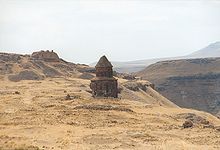This is an old revision of this page, as edited by RussBlau (talk | contribs) at 16:43, 26 May 2005 ({{disambig}} notice removed per guidelines on Misplaced Pages:Disambiguation). The present address (URL) is a permanent link to this revision, which may differ significantly from the current revision.
Revision as of 16:43, 26 May 2005 by RussBlau (talk | contribs) ({{disambig}} notice removed per guidelines on Misplaced Pages:Disambiguation)(diff) ← Previous revision | Latest revision (diff) | Newer revision → (diff)- For the abbreviation or acronym ANI, please see ANI.
In Etruscan mythology, Ani was the sky god, perhaps equivalent to the Roman Janus. He lived in the highest level of heaven.
The ani is also a bird, a black variety of cuckoo with a heavy bill that can be either smooth or ridged. Unlike other cuculids, it does not lay its eggs in other birds' nests.

Ani (anc. Abnicum) is also an ancient and ruined city of medieval Armenia, situated in Turkey, district of Kars, immediately at the turko-armenian frontier, ; at an altitude of 4390 ft. , between the border river Arpa-Çai (turkish) / Akhurjan (armenian) (Harpasus) and a deep ravine. In the tenth century the town of Ani was expanded into a major city by Ashot III, who made it the capital of Armenia under the Bagratid dynasty (961). When it was handed over to the Byzantines in 1045, it was a populous city, known traditionally as the "city with the 1001 churches." It was then occupied by the Seljuk Turks in 1064, getting under White Sheep Turkmen, Black Sheep Turkmen sovereignty later. It was taken five times by the Georgians between 1125 and 1209, in 1239 by the Mongols, and its ruin was completed by an earthquake in 1319. It was slowly abandoned after the 14th century, being dominated by the Ottoman Empire after 1534 and under the invasion of the Russian Empire from 1878 to 1917. Ani is now about 42 km (26 miles) away from the Turkish province Kars, near the Arpaçay Brook, a branch of the Araks River that constitutes the border between Armenia and Turkey, within Turkish borders. The city now known for its well-preserved ruins of medieval Armenian architecture, although the ruins are threatened by the dynamite blasts at a nearby stone quarry in Armenia, as well as Turkish efforts, largely ignorant of the architectural continuity of the ruins, to "rebuild" them. It is still surrounded by a double wall partly in ruins, and amongst the remains are a "patriarchal" church finished in 1010, two other churches, both of the 11th century, a fourth built in 1215, and a palace of large size.